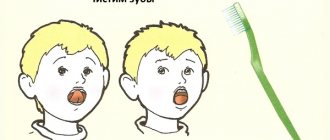Online speech therapy exercises
Speech therapy of vowels:
|
| | | | | | | | | Difficult vowels:
e;e;yu;ya |
e;u;e;y;a;o;e;ya;i;yu | Setting consonant sounds and letters:
|
| | | | | | | | | | | | | | | | | | | Difficult consonants:
b;p | w;w | z;s | g;k | s;ts | v;f | r;l | p;l | r;p;l | z;s;c | h;f;sh;sch;ts;x |
It is better to study often and in short portions than to arrange long lessons, but with long breaks. It is best if the classes take place simultaneously. For example, you go to kindergarten and learn to say a certain word. Or learn a song. Thanks to the site (), the child will learn to overcome speech disorders and build confidence in their abilities. In this section of the site, you will find classes on speech development intended for classes with children from 1 to 7 years old. In individual lessons with a speech therapist, work is carried out on the production of sounds and the development of phonemic perception.
When is a child’s speech correction needed?
The formation of sound pronunciation begins in the first months of life. The first sounds arise involuntarily; they are usually the easiest to pronounce (“a”, “o”, “u”). Up to 3 years, replacement of sounds and distortions in their pronunciation are considered the age norm. By the age of 5, a full-fledged phonemic range is actively being formed.
If by the age of 5 a child cannot pronounce “sh” correctly, it is necessary to help him with the pronunciation of the sound through articulatory gymnastics and other methods.
The production of the sound “Ш” occurs between the third and fifth years of life. At first, the child’s pronunciation suffers and the sound is unclear. Sometimes children use a whistling C instead of a hissing one.
The most common reasons for delays in the stages of speech pronunciation are: improper development of the speech apparatus (problems with bite or frenulum of the tongue); inactive lower jaw.
To begin the correct formation of sound pronunciation, you first need to understand the sounds that are difficult for a child to pronounce, what the difficulty is. The first to be checked is the group of hissing, whistling and sonorant sounds. To check correctly, you need to ask the child to tell a poem, story, or fairy tale.
You can use special cards with images of the letter that needs to be checked.
Violation of a hard consonant is most often accompanied by incorrect pronunciation of a soft one. In this case, the pronunciation of the sound is checked separately from the word. If in this form the child pronounces the sound correctly, then you need to practice by repeating phrases and words. When it is clear that the sound is distorted, it is necessary to begin work on its production.
MISTAKES THAT KIDS MAKE
Despite the fact that the sound Ш is a voiceless consonant, it is pronounced clearly and loudly. Children in early preschool age can distort this sound in different ways. Specialists in the field of speech therapy identify the following common errors in the speech of children: - interdental pronunciation - the child has a lisp due to the tongue being strongly pushed forward, F is heard instead of W; - nasal pronunciation - the baby will raise the back of the tongue in the hard palate, due to which the air flow passes into the resulting gap, X is heard instead of W; — the passage of an air stream into the gap between the teeth and the cheek, because of this, instead of squelching, a squelching sound is heard; - replacement of Ш with other sounds, most often these are S, T and soft Ш. Speech therapists also note such a deviation as the pure pronunciation of the sound Ш with incorrect articulation. Adults should monitor how their child produces this sound and take measures to correct speech defects.
Reasons for the absence of the correct "Sh"
If we are talking about a healthy child with normal hearing and intact intelligence, the following reasons for distorted sound pronunciation are identified:
- Incorrect speech breathing. If there are breathing problems, the child’s speech remains quiet, he stumbles over every word, and the end of the sentence is swallowed due to lack of air. The same process is observed in sound pronunciation; many sounds are distorted due to difficulty in speech breathing. You can notice difficulties when the exit during a conversation is sharp, through the nose. The child can also take small breaths to finish the sentence. You can practice at home. With daily practice that lasts no more than five minutes, the results will appear within a month, which will significantly speed up the process of sound production.
- The problem is speech hearing. Thanks to phonemic hearing, it becomes possible to distinguish consonant words. A deviation occurs when a child does not notice differences in his pronunciation from other people. Impaired speech hearing leads to difficulties in learning to write and read. In some cases, dyslexia develops. The formation of speech hearing should be addressed from the moment of pregnancy, when auditory receptors begin to form in the fetus. Phonemic hearing develops by the age of four, so if after this age the child still pronounces sounds incorrectly or does not agree on the endings in words, this is a reason to contact a specialist. A comprehensive examination and medical history will help to more accurately determine the direction of correcting the disorder.
- Poor development of the articulatory apparatus. The quality of sound pronunciation depends on the functioning of the speech apparatus and the individual work of the organs of the oral cavity. Sounds are formed in the oral cavity, so the correct location of the organs that are responsible for speech plays an important role in sound pronunciation. Incorrect structure may include an incorrect bite, the structure of the palate, or the formation of teeth. All this leads to the formation of blurred speech, unclear pronunciation of words and sounds. For accurate sound pronunciation, it is necessary to develop motor activity of the tongue, lip mobility (smile, rounding), and fixity of the lower jaw.
- Individual structure of the frenulum. All people have different lengths of the hyoid frenulum. Problems with the correct production of sounds may arise if parents notice that the child does not reach the upper palate with his tongue, the tip of the tongue does not protrude, and the child cannot make a clicking sound. A short frenulum prevents the sucking reflex and creates an incorrect bite. You can correct the problem with the help of a speech therapist or dentist. Surgery to trim the frenulum is required for children who exhibit a lump or attachment to the actual tip of the tongue. In cases where structural problems have not been identified, they suggest developing the ligament with special exercises and massage. Usually, problems are identified during examinations of newborns, who can have their frenulum cut immediately in the maternity hospital.
Speech therapy diagnostics
The speech therapist evaluates the development of all components of speech to determine a speech defect. In case of distorted pronunciation of sounds during diagnosis, he pays special attention to:
- appearance of the lips, state of the bite, muscle tone of the tongue;
- articulatory and facial motor skills;
- duration and force of exhalation;
- pronunciation of sound in isolation, in syllables, words, phrases and coherent speech;
- whether the child distinguishes it from other phonemes.
When assessing the anatomy of the articulatory apparatus, the specialist looks at the bite, palate, appearance of the tongue (too narrow or clumsy wide), and the hyoid frenulum. If there are any deviations that may be the cause of the distortion, the speech therapist can refer you to other specialists (surgeon, orthodontist).
When checking the work of facial muscles, the speech therapist asks the child to depict emotions (joy, sadness, surprise, etc.); checks how the facial muscles work individually (asks you to raise your eyebrows, smile, etc.); In addition to motor skills, the child is shown images of various emotions and must choose the appropriate mood for each picture.
During the diagnosis of articulatory motor skills, the speech therapist gives tasks for statics (retention) and dynamics:
- Smile, stretch out your lips in a “tube” or take a position as when pronouncing O. You need to fix them in a certain position for a few seconds.
- Move your jaw in different directions.
- Relax your tongue, make it wide, place and hold it on your lower lip, or make it narrow, extending it as far as possible.
- Perform the “cup” exercise.
- Raise - lower the tongue.
- Move them in different directions.
- Draw a horse.
All exercises are performed by demonstration, that is, the adult shows first, and the child then repeats. The speech therapist notes from what time the child was able to complete the task correctly or when he failed; draws attention to the state of muscle tone of the articulatory apparatus.
To check the strength and duration of exhalation, it is suggested to perform the following tasks:
- blow off a light object (feather, piece of cotton wool);
- play the game “Who will kick the ball further” - the child competes with an adult who will blow out the object further;
- play the pipe.
Before performing tasks, the speech therapist explains how to breathe correctly. During diagnosis, he also pays attention to the formation of speech breathing.
When examining the sound-pronunciation aspect of speech, the speech therapist examines all groups of sounds. When a child pronounces a sound, the speech therapist pays attention to the position of the articulation organs. At first, the phoneme is pronounced separately from the others. Then in various syllables (SHA, OSH, USHU, ShPA, etc.); in words, and the sound must be at the beginning, middle or end (HAT, MOUSE, RESED, etc.).
Then the speech material is complicated, and the child repeats phrases and sentences after the adult (BIG EARS, DASHIN'S FUR COAT, WIDE SCARF, etc.). To check the pronunciation of Ш in independent coherent speech, use the following tasks:
- make up a phrase/sentence from the given words;
- who can name more objects that have Sh in their names;
- tell what is drawn in the plot picture.
Speech and visual material should be selected taking into account the child’s age. When checking the pronunciation of a particular sound, you do not need to use words containing mixed groups and oppositional phonemes.
The speech therapist also checks the state of phonemic hearing and the skill of sound-letter analysis. For this purpose, special tasks are selected:
- do some action after hearing a given sound (it is pronounced separately, in combination with other phonemes);
- Determine the position of a sound in a word.
Based on the results of the examination, the speech therapist draws up a plan of correctional work and selects appropriate methods of sound production.
Articulation gymnastics
The consonant sound “Ш” does not have a paired soft sound; by its nature it is dull and hard. When pronouncing, the speech apparatus is built in a special way:
- lips move forward a little;
- the tip of the tongue does not touch the palate when raised;
- the tongue itself is shaped like a ladle, without releasing exhaled air on the sides;
- there is space between the ligaments, the stream of air feels warm when you put your hand up.
Producing the sound Ш to a child in stages involves the formation of the correct articulatory apparatus.
Articulatory gymnastics serves to develop the correct arrangement of organs with subsequent sound pronunciation of hissing sounds. The technique is carried out several times every day, lasting five to six minutes. The selection of exercises should start from simple to more complex.
It is better to conduct it with preschoolers and primary schoolchildren in a playful way, which is the main activity at this age. This way the child will not lose interest and motivation. Strengthening exercises should be diluted with new ones after the first ones have improved.
They begin to train using a mirror so that the child sees not only the adult and his articulation, but also his mistakes and successes. When conducting special exercises, a parent or specialist only tries to control the process of implementation.
It is important to reinforce the results with a positive assessment of any actions. Improving the emotional background leads to diligence in performing gymnastics.
Staging exercises from sound C
The most common method of producing the sound Ш from S. This method is used when no impairment of the mobility of the speech apparatus is detected. Even a not loud whistling sound will be useful for staging hissing ones. The child needs to raise his tongue to the roof of his mouth and pronounce S without tension. After that, he needs to release the air when pronouncing. This produces a sizzling Sh.
The air should come out without unnecessary effort, the child should not strain his facial muscles or make excessive facial expressions . The sound “Ш” is introduced to the child in stages in order to clearly explain the differences in the position of the tongue. Children often confuse the upper position with the sound S with the lower sound Ш, which is why a mixture of whistling and hissing occurs.
Exercises for setting the sound T
If there is interdental sigmatism, the child is gradually given a hissing T. They are first taught to touch the upper teeth with the tip of their tongue, going slightly beyond them. Thus, the development of the T sound begins.
The child is asked to pronounce the soft T several times in a slow rhythm, touching the tip of the tongue to the roots of the upper teeth. Then, lengthening the exhaled air, without touching the teeth, the sound Sh is produced.
Exercises for setting the sound R
In cases where the child has a normal pronunciation of the sound R, the production of the sound “Ш” is made from it. The exercise is performed together with the child in front of the mirror. It is necessary to pronounce the sound R in a whisper, gradually removing the air pressure when exhaling until the vibration stops. After the appearance of a slight hiss, the sound Ш will become without pronouncing R.
Exercises for setting the sounds A, E, Y
When the problem of producing the sound Ш from consonants arises, it is recommended to use vowels. This technique is difficult to use at home because it requires skills in operating a speech therapy probe. The child pronounces vowel sounds and raises the tongue to the palate with a special tool.
Preparatory stage
If a child does not have the sound [Ш], then this is sigmatism, when it replaces or distorts the sound - parasigmatism. Correctly identifying the cause of a defect allows the correction process to be effective.
You can try playing the sound [Ш] at home. To do this, you need to follow a sequence of steps. The first one is preparatory. It is necessary to perform articulation gymnastics - a special set of exercises for muscle development.
Sample exercises for a hissing group:
- “Punish a naughty tongue” - the mouth is wide open, the wide tongue lies on the lower lip. You need to gently spank it with your upper lip or bite it lightly. The action is accompanied by the pronunciation of a syllabic path: five-five-five.
- “Spatula” - the mouth is open, a wide tongue is placed on the lower lip and held in this position for 5 seconds.
- “Cup” - the mouth is wide open, the tongue lies relaxed on the lower lip, it is necessary to bend its lateral edges. A more complicated version - the “Cup” is moved behind the upper teeth.
- “Mushroom” - open your mouth slightly, press your outstretched tongue to the palate and hold in this position for 5 seconds.
- “Accordion” - position as in the previous exercise. The lower jaw goes down, then goes up. The tongue should remain glued to the roof of the mouth.
- “Horse” - with the mouth slightly open, the tongue is sucked to the palate and opens, producing a characteristic sound.
- “Donut” - lips forward and slightly rounded.
The purpose of articulation exercises for the sound [Ш] is to develop tongue movements. Therefore, they are performed in front of a mirror so that the child can control himself. It is necessary to pay attention to the quality of actions.
Another important part of the preparatory stage is breathing exercises. The preschooler is asked to blow small paper balls from the surface of the table or a hex pencil. It is important to ensure that his cheeks puff out at this time. Another useful exercise is Focus. The child is asked to make a “Cup”; a small piece of cotton wool is placed on the tip of the nose. The preschooler must blow it off so that it flies up.
When articulation and breathing exercises are well mastered, you can move on to sound production. In special kindergartens for children with speech disorders, group and individual lessons are provided for children. This allows them to better assimilate the material.
Setting the sound “SH”
The sound “Ш” is dull, soft in pronunciation, described in some cases as Шь.
Articulation of the sound “Ш”: the tip of the tongue must be raised to the alveoli while pressing the lateral edges of the tongue against the upper teeth. The muscles should be tense. When exhaling, press the tip of your tongue onto the roof of your mouth. The lips take on a rounded shape. The distance between the teeth should be no more than five millimeters.
Raising your hand to your mouth, you can feel a stream of warm air as you exhale. There is no vibration because the sound is dull. The sound Шь is produced after the pronunciation of Ш is normalized. The sound Шь, unlike Ш, is pronounced more drawn-out and tense. When spoken, the tongue presses on the roof of the mouth.
“SH” can appear independently after all the hissing sounds have been produced. If this does not happen, special speech therapy techniques are used. You should start with imitation exercises. In this case, the child is offered play techniques (imagine a hissing snake, a small train).
Be sure to use tactile techniques to check for correct articulation.
When the correct sound pronunciation occurs, the child is asked to pronounce the sound for a long time, stretching out a smile and pushing the tongue forward, until the sound appears.
HOW TO PRONECT THE SOUND CORRECTLY
The purity of the pronounced sound directly depends on the correct position of the tongue and lips during pronunciation. The articulation of the sound Ш is as follows: — the lips are elongated into a tube shape; - teeth are clamped or brought as close as possible; - the tip of the tongue is raised to the hard palate, but does not touch it; - the tongue on the sides is tightly pressed to the teeth of the upper jaw; — the air flow should pass through the center of the tongue; - the soft palate is slightly raised and blocks the nasal passages; - The vocal cords should be open. The articulation of the pronunciation of hissing sounds is quite complex; parents cannot always do this without the help of specialists. Therefore, it is better to consult a qualified speech therapist.
Automation of the sound [ш] in syllables
Consolidation of sounds in syllables, words, sentences must be carried out in the form of a full-fledged lesson or homework. In order for the child to be actively involved in the lesson process, it must take place in a playful way.
It is necessary to prepare in advance the equipment that will be used. These could be toys, drawings with sound, methodological developments, speech therapy tools.
Mimic gymnastics
Classes begin with special articulatory gymnastics, which will prepare the speech apparatus for the exercises and relax the facial muscles.
Mimic gymnastics includes the following exercises:
- Move your lips left and right, stretching your facial muscles. Perform five times in one direction and the other, rest, repeat four more times.
- Alternately puff out your cheeks, repeating the exercise five times with a short rest.
- Frown your eyebrows, pout your lips, making an offended, capricious face. Practice an angry facial expression by pursing your lips. Make a surprised expression by raising your eyebrows. Repeat each exercise four to five times.
- Alternate rapid blinking with calm, relaxed opening and closing of the eyes.
- Trace the contour of your lips with your tongue, as if licking the remnants of jam or ice cream on your face.
- Make faces, make funny facial expressions, form your lips like a duck.
Each exercise can be accompanied by a poetic rhyme or an entertaining story. In this way, the child will not only develop facial expressions, but also train speech and memory.
Breathing exercises. Making the sound Ш while inhaling
Introducing the sound Ш to a child can be done step by step with the help of breathing exercises.
The most successful is the sound pronunciation through T. First, you need to ask the child to pronounce the sound T for a long time by touching the tip of the tongue to the inside of the upper teeth. The sound should produce a stream of air, which is noticeable when you bring your palm to your mouth. Then you need to exhale the air and make the sound T with a short breath.
The child should draw in air without using the larynx. It is necessary to draw in air until the tongue rests firmly on the alveoli. The sound should be similar to a rustling sound, which at the same time releases a chill on the cavity of the upper teeth.
After a rustling sound is heard, it is important to push the air back out with a sound after drawing in. At this stage you should get a soft Sh.
Positioning must be done carefully with short rests to avoid hyperventilation, which can lead to dizziness.
Mechanically assisted setting
To produce some sounds, special speech therapy instruments are used that help control the movement of the tongue and lips.
Mechanical placement can be done from the sound C. During prolonged pronunciation, a special probe in the form of a spatula is used to lift the child’s tongue to the upper teeth, moving it slightly back. After receiving the sound Ш, you should try to pronounce it without the help of instruments.
It is possible to have an effect when pronouncing the sound R. To do this, the child must, without a voice, stretch out, pronounce the sound R. Using the tip of the instrument, it is necessary to stop the vibration under the tongue until a hiss appears. After a certain number of repetitions, the hissing will occur involuntarily.
Introduction to independent speech
The production of the sound [Ш] is gradually aimed at eliminating the speech impediment. Consolidating a new stereotype takes time. Sometimes this takes about a year. Automation begins with direct syllables: sha, shu, shi, she and the like. As a task, the child is offered:
- slide your finger along the sound track and help the snake reach another object;
- lay out colorful stones on the table and pronounce the syllables;
- clap your hands or jump around the room, each movement accompanied by a syllable.
When it is possible to achieve a good sound, reverse syllables are introduced - ash, osh, ush. You always need to come up with new games, as children quickly get bored with mechanical repetition. You can introduce pure phrases: the child pronounces the syllables, the adult pronounces the rest of the phrase:
- The preschooler says: “Sha-sha-sha.
- The adult finishes: “….Dasha has porridge.”
After the pronunciation of syllables is fixed, automation in words begins. To begin with, take a group where [Ш] is at the beginning - hat, tire, fur coat. You can come up with many games with this material. For example, a picture with a spike and numbers is offered. The child's task is to count - one thorn, two thorns, three thorns and so on. It is important that he says exactly two words.
You can play “say the word” with the ball. An adult throws a toy into the hands of a preschooler, says the word “Maly.”, The child’s task is to add [Ш] and name the whole word. To develop memory, a number of words are offered that the preschooler must repeat. If it is difficult for him to reproduce four words, the series is shortened. After they manage to consolidate the pronunciation of the words of the first group, they move on to the group with a position in the middle of the word, then at the end. Only then do they move on to proposals.
Another part of the work is differentiating the sounds [Ш] and [С]. Each one has its own symbol, for example, a snake and a pump. The characteristics of each sound are discussed with the child, drawing the preschooler's attention to the differences - when pronouncing [S], the air is cold, when pronouncing [Ш], it is warm. The material is taken in the same sequence as during automation - syllables, words, sentences.
Strengthening pronunciation
Exercises to automate the sound “Ш”
Exercise on adding endings with the sound “Ш”:
| SHA | SHI | SHU |
| Doll Yes... (sha). | Masha cleans the... (shi). | In the library you have to be quiet... (SHE). |
| Girl Nata... (sha). | We squeak... (shi). | Mom gave candy to Ma...(SHE). |
| Son of Ale... (sha). | Landas are collected in the forest... (shi). | |
| Parrot Kiryu... (sha). | Little ones don’t go to school... (shi). |
Replace the first sound with Ш: slippers - hats, lips - fur coats, soap - awl, steam - ball.
Form a diminutive word: winter - winter, aunt - aunt, mistress - hostess, bread - bread, spot - speck.
Exercises to improve speech hearing:
- Guess the animal. You need a tape recorder with recordings of the sounds of various animals. The child needs to differentiate and name the animal.
- Finger game "Weather phenomena" . The one who conducts the game must name one of the phenomena; the child must knock on the table. For example, when pretending to thunder, a child needs to knock on the table with his fists. Depict lightning with light strikes of the fingers, while pronouncing a long sound Sh.
Gaming techniques
To make the lessons more interesting and entertaining, prepare pictures or toys with “hissing” animals (goose, snake) and objects (a flat tire, a balloon, a ball). Show the goose how it stretches its neck and hisses, as if it wants to pinch a child. The boy was playing with a balloon, and it got stuck on a branch. And here you can use “sound tracks” - draw the path of the snake, how it crawls and hisses. A car is driving down the road with a flat tire.
After the sound is established and the baby can pronounce it more or less independently, you can move on to consolidating it in syllables, words and sentences. And at the same time try to place other hissing words: Ж, Ш, Ш, differentiating them from each other and from the whistling ones. All these exercises develop phonemic awareness very well, and the exercises “find the place of a sound in a word” or “come up with a word for this sound” also involve sound-letter analysis and synthesis, which is a good preparation for school. Much more useful than forcing your baby to read.
This concludes writing this article. There will be others where I will continue to talk about fixing the sound Ш and distinguishing it from S. So subscribe to new articles to always stay up to date. Share your impressions on social networks, and also write about your experience in the comments on the blog. Best wishes!
How to promote speech development in children
- Create a supportive, conversational environment. During the first years of life, a child learns language by imitating his parents. Therefore, by constructing correct sentences, using complete words, literate speech can help the child in the formation of speech.
- It is important to comment on all actions performed not only by the child, but also by the parents. This promotes the active acquisition of concepts, an effective part of speech.
- Gradually introduce a generalization of concepts and meaning-forming connections. Show actions with various objects, ask to perform manipulations, always voicing them.
- The play activity that accompanies a child in the first stage of life is a favorable environment for using various poems and jokes in his speech. They can voice actions.
The correct pronunciation of all sounds, including the sound “SH”, is taught to a child in stages for the development of correct speech. Not only a speech therapist can help with this, but also daily independent activities that can be turned into a game so that the baby makes contact more actively.
Important points
With children of preschool age, the concept of “letter Ш” is taught only in the preparatory group. Before this, there is no need to focus the child’s attention on this. It is important to explain to him only one point: the sound is pronounced and heard, the letter is written and read. Everything else is best left for the school period. You should not transcribe the words, as this is a complex topic. You can conduct sound analysis classes with preparatory group students.
Help for children with speech disorders is provided in kindergartens, clinics and special centers. It is better not to delay contacting specialists, since the sooner a defect is identified, the faster it will be eliminated.









